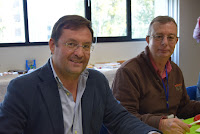Fascinated as anyone would be for Chinese Opera and everything it entails I didn't hesitate to go to the second floor of Museu do Oriente, where a temporary exhibition on such a theme was being held, in search of those visual images.
I was immediately drawn to the beauty of the costumes and the meaning of the designs therewith associated, as I walked into the first exhibit room.

Ceremonial court costume for a male character (sheng) with embroidered dragon and waves - Beijing c. 1970.

Female character costume (dan) with phoenixes, peonies and "sleeve waves" (to add to the movement in dance and thus produce a visual effect as seen in the image underneath) for an empress, imperial concubine, princess, female warrior and general or a bride of a hish society rank family - Beijing - c. 1980.


Bamboo knit apparel (left).


Budhist Monk costume - Beijing c. 1970 (right)

Costumes for female monk and boatman (main characters of the Autumn River opera) - textile - Beijing c. 1970.
Another exhibit room further enhanced the value of the opera characters subdivided in a vast array of typical ones and the importance of their individuality together with the role played by not only the costumes, but hte accessories and make-up.



Caoxie sandals (for low class social status characters) and shoes for officials - Beijing c.1979/80 - vegetable fibers, synthetic materials, wood and textile.


Hairpins with zoomorphic and leaf shaped ornaments to be used by female charaters - Hong Kong - 20th century - metal, pearls, jade, rose quartz and other semi-precious stones.


Sichuan masks - papier machê and horse-hair - 1992 (right).
On either side of one of the exhibit rooms one could just sit and watch some opera being played, which I did, though I must confess I had no clue as to which type of vast opera repertoire it was from.
I was equally impressed by the number and wide variety of instruments in display, though the one that mostly caught my attention, not only because of the central position it occupied, was the Yangqin dating from 1925 similar to a psaltery with 28 strings and played with very light sticks.



The embroidered wall hanging on the Three Kings opera (dating to 1993) was very impressive, but what wasn't, to be honest (!) - from the the book of sketches for propitiatory operas, the designs on the variety of well known operas to the rod puppets ...






Character from the Journey to the West opera - Beijing c.1980
Painted rod puppet head

Rod puppets from XuXian, white serpent and blue serpent - Guandong c.1950.

Character (1970) from the Romance of the Three Kingdoms, as well as engraving therewith associated (1920).
I may not have been able to fully understand the whole tradition associated with Chinese Opera but Icame out of this exhition with a certainly deeper understanding of what it is about.











































































